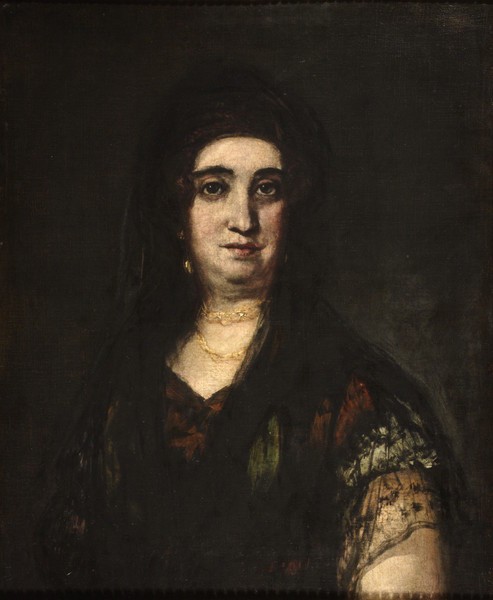- Cronología
- Ca. 1824 - 1825
- Ubicación
- Museum of Zaragoza, Zaragoza, Spain
- Dimensiones
- 61 x 51 cm
- Técnica y soporte
- Oil on canvas
- Reconocimiento de la autoría de Goya
- Documented work
- Titular
- Government of Aragon
- Ficha: realización/revisión
- 06 Apr 2010 / 11 Dec 2024
- Inventario
- (51118)
This work belonged to the collection of Gustavo Bauer, in Madrid, then to that of Emil Bührle, in Zurich, and later to an unknown private collection. It was acquired by the Aragonese Regional Government at an auction held at the Madrid home of Edmund Peel on 28 February 1991.
From December 5th, 2024, and while the Zaragoza Museum remains closed for works, the painting is part of the exhibition 'Goya. From the Museum to the Palace' in the Aljafería Palace in Zaragoza.
The woman with the mantilla had usually been identified as Leocadia Zorrilla de Weiss (Madrid, 1788-1856), Goya's housekeeper and companion during the final years of his life. It was Xavier de Salas who, in the appendix of Sánchez Cantón's work on the Black Paintings, made the connection between the woman in this portrait and Leocadia, the name that Brugada gave to the woman in A Manola in the inventory he made of the paintings found in the Quinta del Sordo. Some scholars, including Gudiol and Camón Aznar, insist that this woman was Goya's supposed lover. However, other writers have pointed out that Leocadia's age at the time of Goya's death was thirty-nine, and the woman shown in this work appears to be somewhat older. Without documentary evidence to shed further light on this question, however, it is not possible for now to know for sure who the woman painted in this work is. The portrait depicts a mature woman, dressed in black and wearing a black mantilla. She wears a gold necklace and earrings. The half-length portrait shows her looking straight out at the viewer but with her body turned slightly to one side. Her face is dominated by her large, dark eyes, the witnesses of innumerable experiences, and we sense a certain hint of pride in the half smile that is drawn upon her lips. Considering that Leocadia was a woman with a strong temperament, if this were a portrait of her, this expression on her face could be a subtle allusion to her character.
As in all of the portraits that Goya made in the final years of his life, the colour palette is limited to dark tones and white, used in particularly strong contrast in this portrait, where the pale skin of the lady stands out dramatically from the black background. Of particular interest are the details of the see-through mantilla over her arm, as well as the darkness of the background, which holds the figure fast and blends into her outline.
-
Goya and his timesThe Royal Academy of ArtsLondon1963cat. 66cat. 111
-
Realidad e imagen. Goya 1746 – 1828Museo de ZaragozaZaragoza1996consultant editor Federico Torralba Soriano. From October 3th to December 1st 1996cat. 65
-
Goya. From the Museum to the PalaceZaragoza2024cat.127
-
L'œuvre peint de Goya. 4 volsParís1928-1950vol. II, p. 231, cat. 521
-
Goya y sus Pinturas Negras en la Quinta del Sordo [apéndice de Xavier de Salas]BarcelonaVergara ( Milán, Rizzoli)1963p. 85
-
Vie et ouvre de Francisco de GoyaParísOffice du livre1970pp. 298, 377, cat. 1566
-
BarcelonaPolígrafa1970vol. I, p. 382, cat. 721
-
L’opera pittorica completa di GoyaMilanRizzoli1974p. 132, cat. 617
-
Francisco de Goya, 4 vols.ZaragozaCaja de Ahorros de Zaragoza, Aragón y Rioja1980-1982vol. IV, p. 188
-
Realidad e imagen. Goya 1746 – 1828MadridGobierno de Aragón y Electa España1996p. 182, cat. 65 y p. 183 (il.)
-
Goya. From the Museum to the PalaceZaragozaZitro Comunicación2024pp.126-127
